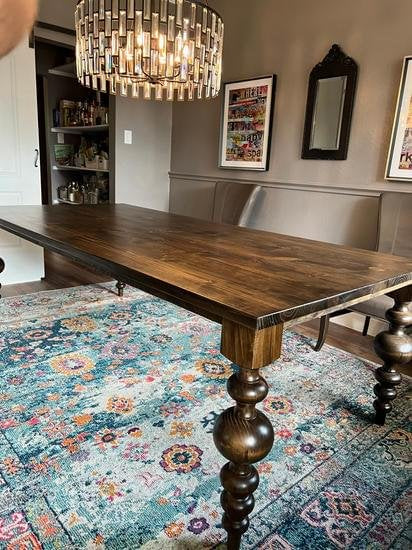From Standard to Modern: Find the Perfect Eating Room Table Legs for Your Design
While classic styles such as cabriole and transformed legs evoke a sense of timeless elegance, contemporary designs like barrette and geometric choices provide a chance for striking visual passion. As you consider these aspects, the question stays: exactly how can you seamlessly integrate these varied leg styles to create an unified eating experience?
Recognizing Table Leg Styles
The variety of dining-room table leg styles can considerably affect both the appearances and functionality of the room. Each leg design adds special aesthetic elements and useful functions, satisfying diverse style choices and usage requirements. Comprehending these styles is vital for picking the appropriate table that lines up with your general interior style vision.
For example, tapered legs supply a tidy, traditional appearance that can improve a room's elegance, while stand bases give stability and take full advantage of legroom, making them optimal for smaller rooms. Barrette legs, a trademark of mid-century modern-day style, introduce a commercial style, permitting for an airy, open feel. Trestle legs stimulate rustic charm, providing durable support and a feeling of timelessness.
Wood legs can bring warmth and appearance, whereas steel alternatives commonly convey a smooth, contemporary ambiance. Eventually, recognizing table leg styles is vital for developing a natural dining area that mirrors individual style while making certain functionality and convenience.
Typical Table Leg Options
When selecting dining-room table legs, typical choices often personify timeless beauty and craftsmanship. These layouts show a rich heritage and a commitment to high quality, making them excellent for those that value classic aesthetics.
One of the most renowned conventional leg designs is the cabriole leg, characterized by its stylish rounded form. This style usually features decorative carvings and is most frequently located in Queen Anne and Chippendale furniture. An additional preferred alternative is the transformed leg, which boasts a series of smooth, rounded shapes that offer a traditional look while maintaining security.
Furthermore, the straight leg, while easy, provides a strong and basic framework that can blend perfectly with a variety of tabletop styles. For those attracted to ornate describing, claw-and-ball feet legs evoke a sense of magnificence and can work as a stunning focal factor in any type of eating area.
Lastly, stand bases, although not strictly legs, give a different traditional alternative that enables adequate legroom and can be perfectly sculpted. Each of these conventional leg designs adds to the overall ambiance of a dining-room, weding function with aesthetic charm.

Modern Table Leg Layouts
Modern table leg layouts use a diverse array of styles that stress cutting-edge materials and tidy lines. These designs usually prioritize capability while functioning as striking centerpieces within a dining area. Minimal visual appeals are widespread, with legs crafted from materials such as steel, glass, and engineered timber, which add to a contemporary and airy feel.
One preferred design is the barrette leg, identified by its slender, conical framework that supplies security without overwhelming the tabletop (dining room table legs). This design is often located visit site in mid-century modern furnishings and can easily complement different dining table forms. Another trend is using geometric forms, where legs might tackle unbalanced or angular forms, including aesthetic passion and a touch of creativity

Mixing Designs for One-of-a-kind Rooms
Commonly, property owners look for to develop distinct eating rooms that check show their personal style by mixing numerous design elements. This approach enables the unification of varied appearances, leading to an unified yet unique environment. Coupling a rustic wooden table with streamlined, contemporary metal legs can develop a distinctive comparison that elevates the space's overall allure.
Furthermore, integrating vintage table legs with modern table tops can stimulate a sense of background while preserving a modern perceptiveness. Such combinations not just showcase private taste however also encourage imagination, allowing house owners to curate a space that feels both personal and welcoming.
Shade plays a critical role in this mixing procedure; picking table legs that complement or comparison with the existing color pattern can enhance visual passion. As an example, whitewashed legs can soften the daring of a dark table surface, producing a well balanced aesthetic.
Tips for Selecting the Right Legs
Picking the right table legs is crucial for attaining both capability and aesthetic appeal in your eating resource area. Begin by considering the general style of your space. Standard settings gain from legs that feature detailed makings or turned designs, while contemporary areas might ask for sleek, minimalist designs.
Next, evaluate the height and security of the legs. dining room table legs. Standard table range between 28 to 30 inches in height, so ensure the legs enhance this measurement for comfort. Additionally, robust materials, such as hardwood or metal, can improve stability and long life
Assess the leg shape also-- choices include directly, tapered, or pedestal styles. Straight legs offer a timeless appearance, while conical legs can include a touch of sophistication. Pedestal bases provide sufficient legroom and are optimal for smaller sized areas.
Final Thought
In recap, choosing the optimal dining area table legs needs careful consideration of both contemporary and traditional designs. By harmonizing leg design, elevation, and material with the total design, a cohesive and welcoming atmosphere can be achieved.
The selection of dining area table leg styles can significantly affect both the aesthetics and capability of the area. Inevitably, comprehending table leg designs is necessary for creating a cohesive eating location that reflects individual style while making sure practicality and convenience.One of the most renowned typical leg styles is the cabriole leg, defined by its elegant rounded form. Straight legs use a timeless look, while tapered legs can include a touch of elegance.In summary, choosing the suitable eating room table legs needs mindful consideration of both contemporary and standard designs.